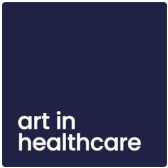In September 2013, I started doing a Masters in Modern and Contemporary Art at the University of Edinburgh. As a part of this programme, I had the chance to do an internship in Art in Healthcare (AiH) from October to March 2013. This organisation enabled me to discover the process behind the charities which aim to enliven healthcare settings through the healing power of visual arts.
Throughout these 6 months, I mainly worked in close connection with the Outreach Manager Amelia Calvert and was in charge of organising small displays, reviewing feedback forms, helping with cataloguing and small-scale curations and managing the art collection. As part of this role, I also organised the Art Works! Exhibition which was held in Out of the Blue Drill Hall between the 17th and 20th of March – the second of a series that started in 2013. Before and during the exhibition, I was in charge of searching for the exhibition space, designing the posters, wall texts and fliers, keeping in touch with artists and managers of healthcare settings, collecting and choosing artworks from workshops, planning the opening event using a budget and asking for help from current interns and staff when needed. This internship adventure definitely developed my individual skills in communication, problem solving, time management and curating and I believe that it created a base for my future projects and plans after my academic life.
Since September 2014, I have been working in a commercial contemporary art gallery (ART350, Istanbul) as the Associate Director and I believe that working in AiH as an intern benefited my current role and responsibilities. ART350 is a gallery which aims to support both Turkish and foreign contemporary artists who are working in the areas of painting, photography, sculpture and installation. The exhibitions are planned to be displayed for an optimum time to give the opportunity for international art lovers to visit besides locals. The gallery further aims to be a platform for public art discussions, workshops and interdisciplinary readings. It is crucial to give the chance to the new discovered young artists to exhibit for the purpose of developing the knowledge of the public regarding contemporary art.
In the office, I mostly do all the work that I had done for AiH as well as having responsibility for some further details – artist liaison, organization of the exhibitions, held every 6 weeks, organisation of the collections and works, writing the catalogue text and writing all the English/Turkish texts for the online platforms and advertisements for newspapers and magazines. I am also in charge of increasing the number of visitors through public relations and constantly keeping in touch with other galleries and collectors.
While the main difference between a commercial art gallery and a charity working for the public good is economical – by this I mean that there are different priorities for the two settings in terms of purpose and aims – the overall processes behind both organisations are about the same. These are mostly creative and technical details which form a general daily routine and develop the projects. AiH helped me develop my English and I learned how to write formal e-mails to artists and managers in another language. This is again a very important process in order to run the projects and exhibitions on a daily basis both for the gallery I work in now and for AiH during my internship. Even though ART350 is a gallery based in Istanbul, half of our prominent artists are international; Dutch, German, Spanish, English, Hungarian, and so on. Therefore, the skills I developed in AiH, especially when my communication with the artists and managers are considered, helped me in areas such as artist relations and talking in public, such as at the exhibition openings.
Another advantage of working in AiH was being in the office with a team and communicating informally while maintaining professionalism; the staff were very friendly and helpful and I could easily ask everything in the areas that I needed help. Based on the experience I had in AiH, I am a more social person and never hesitate asking questions or demanding for help from my new colleagues in ART350. Another skill learnt was in the technical processes regarding the artworks; carrying paintings and organising our collections, writing the work details and numbers, designing posters and flyers are all the technical processes which form an exhibition in the end and I primarily learned this in AiH with the considerable help of the Outreach Manager and the displays that we organised together.
All in all, while both positions may be different in each organisation – AiH working as a student and now as a Masters graduate – the tasks and responsibilities regarding the work are very similar. This is an important fact highlighting how an internship programme is beneficial for a student’s future career and I am very satisfied with both of my roles which are strongly related to each other today. Both of them work for the public, the artists and art itself, don’t they?
Many thanks to my supervisor, Amelia Calvert, all staff in AiH and the staff in ART350 for helping me become more professional day by day.
Gizem Gedik, The University of Edinburgh/Art350, January 2015
29 January 2015 by
Art in Healthcare
